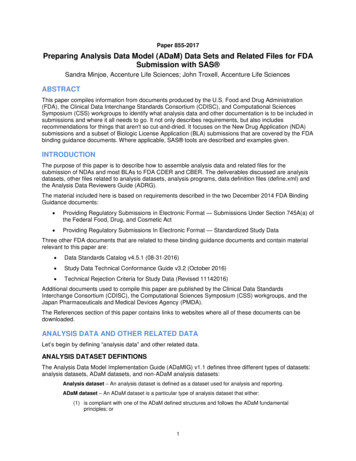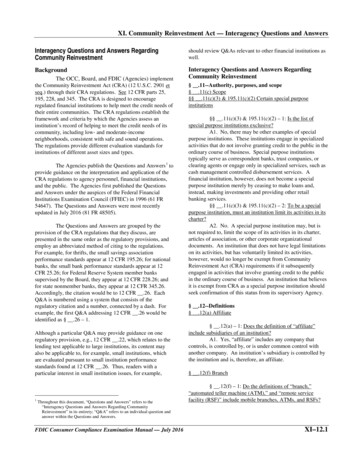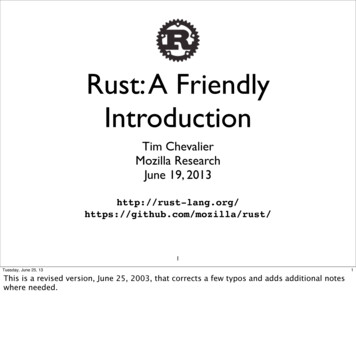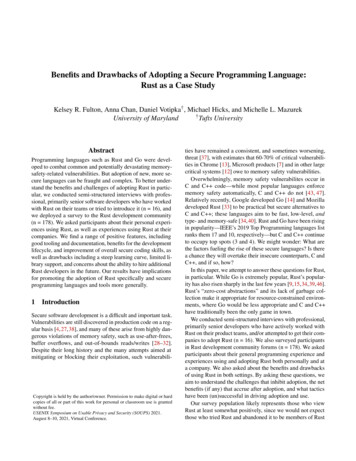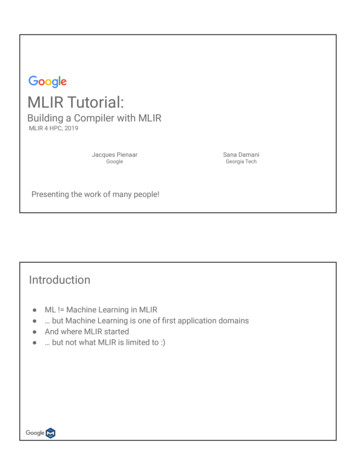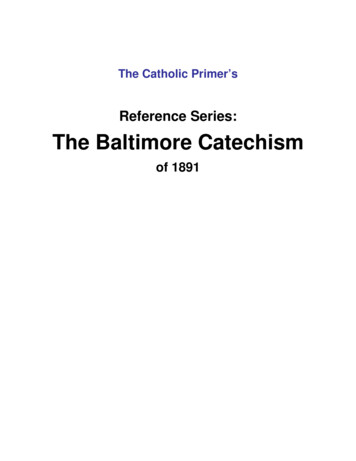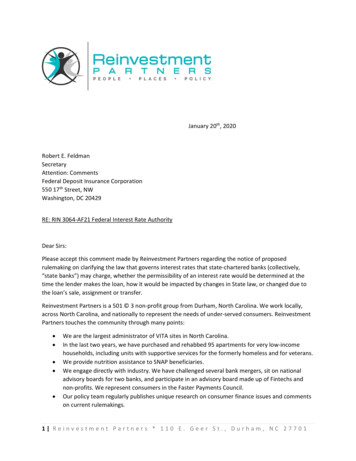
Transcription
January 20th, 2020Robert E. FeldmanSecretaryAttention: CommentsFederal Deposit Insurance Corporation550 17th Street, NWWashington, DC 20429RE: RIN 3064‐AF21 Federal Interest Rate AuthorityDear Sirs:Please accept this comment made by Reinvestment Partners regarding the notice of proposedrulemaking on clarifying the law that governs interest rates that state‐chartered banks (collectively,“state banks”) may charge, whether the permissibility of an interest rate would be determined at thetime the lender makes the loan, how it would be impacted by changes in State law, or changed due tothe loan’s sale, assignment or transfer.Reinvestment Partners is a 501 3 non‐profit group from Durham, North Carolina. We work locally,across North Carolina, and nationally to represent the needs of under‐served consumers. ReinvestmentPartners touches the community through many points: We are the largest administrator of VITA sites in North Carolina.In the last two years, we have purchased and rehabbed 95 apartments for very low‐incomehouseholds, including units with supportive services for the formerly homeless and for veterans.We provide nutrition assistance to SNAP beneficiaries.We engage directly with industry. We have challenged several bank mergers, sit on nationaladvisory boards for two banks, and participate in an advisory board made up of Fintechs andnon‐profits. We represent consumers in the Faster Payments Council.Our policy team regularly publishes unique research on consumer finance issues and commentson current rulemakings.1 Reinvestment Partners * 110 E. Geer St., Durham, NC 27701
We believe our variety of programming gives our organization the grounding to speak with authority onthe impact that the FDIC’s proposed rule would have on vulnerable consumers.We know that the results of this decision if applied beyond the specific scope of that case, would lead toharm for consumers, as the same practice fostered a widespread system of high‐cost lending until 2001.Before then, a set of banks headquartered in “usury‐friendly” states (a term utilized in a recent case inthe US District Court for the Eastern District of Pennsylvania) assigned recently‐originated loans topayday lenders under the regulatory cover of pre‐emption. North Carolina was among a long list ofstates where payday lenders operated using the space created by pre‐emption.Now, the Federal Deposit Insurance Corporations proposes a new rule which would reinstate thatenvironment, authorizing banks to facilitate high‐cost loans. The new rule would walk back theexpressed will of North Carolina (and many other states), opening the door for a revival of a legalloophole that allowed banks to bypass state anti‐usury law. Doing so would represent a dangeroususurpation by the federal government of state power in North Carolina, as the North Carolina GeneralAssembly has clearly expressed its preference to set interest rate caps at thirty percent – far below anyof the rates offered through the rent‐a‐bank model.In doing so, the FDIC ignores the lessons from the past at the peril of consumers. Payday lenders havetried to sidestep state rate caps for many years. Under this proposal, they would have the support of theFDIC to do so. Before 2001, payday lenders partners with several FDIC‐regulated financial institutions tomake loans at rates that were four to twenty times greater than our state’s usury cap. Pre‐emption didnot improve the market for consumers, but instead, it dramatically worsened the nature of short‐termcredit.We have concerns about an intention to apply the “valid‐when‐made” principle as recently decided inMadden v. Midland Funding. We believe that the application of the decision in Madden overstates itspurpose. The assignment of debt differs in clearly‐definable ways from the issuance of loans, even in the“rent‐a‐bank” model. The FDIC should see that distinction and therein utilize the “true lender” standard.It should use its supervisory powers to guarantee that banks deploy safe and sound business practices;indeed, it should never apply policies that enable financial institutions to utilize FDIC‐insured deposits todistribute predatory capital.DiscussionCourts have already found that the “rent‐a‐bank” practice violates established legal precedent.In 2003, the New York Attorney General sued County Bank (Rehoboth, Delaware) and two of itsassociated entities for violating the state’s anti‐usury laws. The violations alleged in the suit addressedthe exact practices contemplated in the FDIC’s proposal. In 2016, a lawsuit in the Eastern District ofPennsylvania indicted a payday lender and his attorney for violating Pennsylvania’s usury cap throughthe rent‐a‐bank evasion.“Companies that made payday loans to Pennsylvania residents over the internet tried tocircumvent Pennsylvania’s prohibition against payday lending by conditioning their loanson the borrowers’ execution of contracts stating that Pennsylvania law does not apply tothose loans. The Pennsylvania Supreme Court, however, invalidated such contractualprovisions in 2008 and 2010 .the practice of a payday lender paying a bank to act as a2 Reinvestment Partners * 110 E. Geer St., Durham, NC 27701
front for the payday lending enterprise to evade state anti‐usury laws were referred toby payday lending industry insiders as ‘rent‐a‐bank.’ From approximately 1997 to 2003,the Hallinan Payday Loan Companies effectively rented County Bank.” (United StatesDistrict Court for the Eastern District of Pennsylvania, 2016)It will be ironic if the defendants in that case (Wheeler Neff and Charles Hallinan) remain under custodyin federal prison because they were found guilty for creating the legal argument for rent‐a‐bank (as wellas tribal lending) while at the same banking regulators saw to make their deception the standard forfederal law.In the late 1990s, under the cloak of County Bank’s charter, Hallinan Payday Loan Companies madepayday loans across all fifty states, even though those loans exceeded usury caps on personal loans inmany of those states. County Bank was not the “true lender,” as it did not supply the capital, nor did itmanage the underwriting of applications, nor did it service the loans, and it was not the ultimatebeneficiary of the interest payments generated from the loans.County Bank’s participation stemmed solely from its location in a “usury‐friendly” state, as described bythe attorney representing the defendants in the case. (United States District Court for the EasternDistrict of Pennsylvania, 2016):“Defendant Wheeler Neff advised Adrian Rubin to relocate his payday lending operationsoverseas or to one of three states that defendant Neff described as “usury friendly,”which meant that they permitted payday lenders registered in those states to issue loansto customers across the county. Defendant Neff identified the “usury friendly” states asDelaware, Utah, and New Mexico. On or about January 29, 2003, Rubin incorporated apayday lending company in Utah, which he called Global Pay Day Loan (“Global”), andopened offices in Salt Lake City, Utah, and Philadelphia, Pennsylvania.”With the enablement of national regulators, other banks followed suit. Notably, the rent‐a‐bank modelallowed banks to facilitate lending at many times the rates permitted by state law. ACE Cash Expressused Goleta National Bank while simultaneously Dollar Financial Group used Eagle National Bank tomake small‐dollar loans with interest rates of as much as 520 percent. History shows that thereinstatement of laws supporting these business practices will not result in modest changes to lending,but will instead empower banks to become a part of an industry that traps consumers in high‐cost debt.Indeed, were it to be that the FDIC permitted the return of rent‐a‐bank, it would introduce practicesthat contradict currently‐state policies related to consumer reliance on the repeated use of debt that isperceived to be inappropriate. In its 2010 guidance on overdraft programs, the FDIC establishedguidelines on how its supervised financial institutions should monitor “excessive or chronic customeruse” of overdraft services (Federal Deposit Insurance Corporation, 2010). The FDIC’s determinationregarding the appropriate reliance on overdraft goes against the empirical evidence of known patternsin payday lending. In North Carolina, for example, payday lenders typically rolled loans over at least fourtimes.While County Bank might not become the gateway for exportation of lending, other FDIC‐regulatedbanks stand ready to play the part. The FDIC is the primary regulator for Cross River Bank (New Jersey),FinWise Bank (Utah), Republic Bank of Kentucky (Kentucky), and Bank of Lake Mills (Wisconsin).3 Reinvestment Partners * 110 E. Geer St., Durham, NC 27701
We know that these financial institutions will export high rates because these companies already makeloans in usury‐friendly states bearing rates of as much as three hundred percent. Indeed, in its mostrecent annual report, online lender Enova indicates that the only thing holding the company back frommoving into other states are interest rate ceilings:We currently do not offer consumer loans in the remaining states or in the District of Columbiabecause we do not believe it is economically feasible to operate in those jurisdictions due tospecific statutory or regulatory restrictions, such as interest rate ceilings, caps on the fees thatmay be charged, or costly operational requirements. However, we may later offer ourconsumer products or services in any of these states or the District of Columbia if we believedoing so may become economically viable. (Enova International Inc., 2019)”Elevate and Enova rent Republic Bank of Kentucky. Enova’s installment loans bear interest rates of ashigh as 99.9 percent. Its Ca hNetUSA payday lending division charges rates of as high as 325 percent.Elevate’s Elastic Line of Credit is an “online line of credit” bearing an origination fee of 5 per 100advanced against the line plus a monthly charge of 5 percent of all open balances (Elevate Credit, 2019).Elevate claims that the effective rate is 97 percent, although some consumers may pay more dependingon the length of the utilization of the credit line. In each case, Republic Bank of Kentucky plays anessential role in the provision of very high‐cost credit.Elevate rents FinWise Bank to operate its Rise installment loan, bearing rates of between 99 and 149percent in sixteen states (Elevate Credit, 2019).Before a 2017 consent order from the FDIC, the Bank of Lake Mills (Wisconsin) partnered with MilitaryCredit Services and Freedom Stores Incorporated to facilitate loans targeted largely at service members.Ironically, in a span of fewer than three years, the proposed rule reflects a complete reversal in how theFDIC interprets the Federal Deposit Insurance Act (12 U.S.C. 1831d(a). (Rosenblum, 2019) Loans sold byBank of Lake Mills to those lenders, along with others made to Word Business Lenders and others, boreinterest rates of approximately 120 percent; at the time, the FDIC forced the Bank of Lake Mills to ceasethese activities. Now, just three years later, it seems to have lost its way.Again, there would be irony, for although it is the Office of the Comptroller of the Currency charged withapplying the pre‐emptive powers of the National Bank Act to its member national banks, the currentarray of bank‐partner lenders broadly fall within the supervision of the FDIC. The National Bank Actarticulates the logic behind pre‐emption, but here we see its implementation occurring through aregulator of state banks. We have to ask for clarity – how is pre‐emption enacted by a banking regulatorwho has no legal justification for pre‐empting?The proposed rule replaces a simple regulatory regime with one that is far more difficult to apply.Once established, it will be difficult to distinguish between evasive partnerships and genuine attemptsby banks to sell loans to meet their liquidity needs or to sell delinquent assets to third‐party debtcollectors. At the moment, regulators can apply judgment. With this change, regulators will have to setaside their discernment. In the Duke Law Journal, John Hannon that “courts applying the true lender testdisregard the form of lending configuration in favor of a searching examination of its substance,considering a variety of factors designed to determine which entity is the actual lender the true lenderdoctrine represents a judicial mechanism capable of imposing a sensible limit on the heretofore endless4 Reinvestment Partners * 110 E. Geer St., Durham, NC 27701
scope of the exportation doctrine while avoiding the uncertain market conditions sown by Madden’sapproach (Hannon, 2018)”The use of a true lender doctrine creates regulatory certainty. Under a rent‐a‐bank relationship, thebank is not the underwriter, the servicer, or the ultimate recipient of future loan repayments. We do notbelieve that it is appropriate to conflate liquidity concerns with the need to flip loans in a matter oftwenty‐four hours to a nonbank lender.By adding so much ambiguity, regulators who do attempt to apply reason to their actions will inviterepresentatives of rent‐a‐bank agreements to litigating their disagreements. The new approach requiresa regulator to make a judgment whose contention would undoubtedly face legal challenges. It mightneed a regulator to invest in years of litigation to prove that a nonbank is the “true lender” in a “rent‐a‐bank” scheme.To establish its right to pre‐empt the types of loans made under the rent‐a‐bank model, a federalbanking regulator would have to demonstrate that the nonbank is not the “true lender.” We stronglyobject to that conclusion. In the rent‐a‐bank model, a nonbank may perform all or some of the followingfunctions: a) provide the real source of the capital, b) act as the advertiser, c) conduct the servicing ofthe loan, d) perform the underwriting and e) receive most or all of the subsequent loan repayments. Insome cases, the nonbank takes a stake in an investment vehicle, whereby it can indirectly participate inthe benefits of the contract. For example, Elevate Credit’s relationship with FinWise Bank givesresponsibility to Elevate for b) customer acquisition and d) underwriting. A) Elastic holds a directownership interest in EF SPV (Elastic Special Purpose Vehicle), whose capital purchases 96 percent oforiginated loan balances. Under terms of the relationship between Elastic and EF SPV, Elastic is the“primary beneficiary.” (Elevate Credit, 2019)Current loan terms and loan performance should underscore the hazardous nature of the lending thatpre‐emption would enable.Rent‐a‐bank relationships put credit in the hands of borrowers who frequently cannot afford to repaytheir debts.The model’s only purpose for existence is to enable lenders to charge interest rates that are not justslightly above state usury caps, but instead, at interest rates that are dramatically greater than the limitsstates would prefer to apply. For example, Elevate Credit reports that the effective APR for a Rise loan(described above) made through its partner relationship with FinWise is 180 percent. Elevate rentsRepublic Bank of Kentucky, an FDIC‐supervised financial institution, and FinWise, another FDIC‐regulatedinstitution.Rent‐a‐bank lending does not rely on an ability‐to‐repay underwriting standard. It results in theorigination of high‐cost loans to borrowers who are frequently unable to afford the cost of the debt.Consider once more the business model of Elevate Credit. Elevate indicates that borrowers default onthirteen percent of Rise loans. The company has a practice of setting aside an additional fourteenpercent of outstanding loans in loan loss reserves. In its description of how those two sets of loanscombine to reflect on their total loan performance, Elevate reports that “cumulative principal loancharge‐offs through September 2019 for each annual vintage since 2013 vintage is generally under thirty5 Reinvestment Partners * 110 E. Geer St., Durham, NC 27701
percent and continue to generally trend at or slightly below our twenty‐five to thirty percent targetedrange. (Elevate Credit, 2019)”The practice creates debt traps. While the company’s SEC filings do not show how frequently borrowersrenew their loans, we suspect that the total number is very high, as the company says thatapproximately three of every seven loans it makes are to a borrower who was a previous customer(Elevate Credit, 2019).These results underscore our concerns over the quality of lending, and while it may not impact thesafety of a bank’s balance sheet, it does describe a harmful business model that may undermine thereputation of the bank and the regulatory standards under which the bank operates.Countering the FDIC’s Basis for the Proposed Rule:In its notice of proposed rulemaking, the FDIC makes the following points to support the proposedregulation:Proposed rule opinion; The assignability of debt, without a corresponding drop in yields, enables financialinstitutions to increase their liquidity in a crisis:While we agree that banks can make use of liquidity to avert threats to their soundness, we disagreethat this concept contributes to any support for this proposed rule, nor does it apply a sensible lens tothe question of how regulators should enforce relationships between banks and payday lenders.To the point of liquidity: rent‐a‐bank contracts do not put pressure on the liquidity of banks. Generallyspeaking, banks hold at least 90 percent of these loans for no more than twenty days – and often foronly two days. There is no virtually no liquidity risk to the bank for loans held in the short run, as thecredit risk associated with those assets does not deteriorate when the bank holds them on its balancesheet. Indeed, a bank sells the loan before a borrower is due to make the first payment on the debt.Is it defensible to contend that a bank would have a bad debt concern when the business modelexplicitly requires a bank to surrender all or almost all of the loan before the first payment is due?Proposed rule opinion: If a usury cap exists, then regulations will disadvantage state banks who competewith national banks.In its 2019 amicus brief (Federal Deposit Insurance Corporation and the Office of the Comptroller of theCurrency, 2019), the FDIC and the OCC jointly contend that interest rate caps can threaten the safetyand soundness of a bank’s balance sheet. The brief points to the situation in the 1970s, when interestrates on medium and long‐term debt reached 18 percent. Rate caps held state banks to originate loansat a ceiling of five percent, and as a result, they could only make loans at rates that were far lower thantheir cost of capital.Right now, It is not the case that rates are ten or even fifteen percentage points higher than prevailingcapital costs. Instead, in the rent‐a‐bank model, pre‐emption facilitates lending at interest rates that areoften 300 percentage points about the cost of capital.The threat does not exist – and experts on Wall Street believe it will not be real – for at least the nextthirty years. Currently‐prevailing interest rates create no urgency, as banks can currently acquire fundsat less than two percent; rates on deposits are usually less than 25/100ths of one percent, and ten‐year6 Reinvestment Partners * 110 E. Geer St., Durham, NC 27701
treasuries sell at less than 1.5 percent. The yield curve is almost inverted, meaning that Wall Streetbelieves that interest rates may be historically low for the next thirty years. Regulators are arguing touse a legal theory to solve a problem that does not exist. Moreover, the “smartest people in the room”have made trillions of dollars in investments with the belief that the problem will not exist for the nextthree decades. Indeed, given that very few regulatory careers expand beyond thirty years, only ahandful of staff may ever experience a moment when this problem needs to be solved.Proposed rule opinion: applying Madden is the best way to address safety and soundness concerns.The FDIC could remedy the actual problem with other approaches.When the bank holds back a portion of the nonbank's loan, then the FDIC could respond in several waysto meaningfully address its concerns about safety and soundness.First, the FDIC could apply a correspondingly conservative standard in how it categorizes retained loansin the formula for determining the bank’s Tier 1 capital ratio. A bank should have to set aside asignificant amount of capital to guard against losses associated with holding loans made through aprocess where, as in the case of Elastic, as much as thirty percent of funds are lost because of poor loanperformance.Republic Bank of Kentucky states that in its Republic Credit Solutions segment, where it holds 10 percentof loans associated with Elevate, “loss rates are for this product has consistently been higher thanTraditional Bank loss rates for unsecured consumer loans.” Republic set aside 16.9 million for loanlosses on a portfolio with a fair value of just 34 million, underscoring the exploitative nature of theseloans (Republic Bancorp, 2019).Secondly, it could extend the time that a bank must hold the loan. The proposed rule indicates that itmight condition the cost of loans on the 90‐day commercial paper rate. To impose a standard requiringa holding period for 100 percent of the debt, even for a term of as little as 90 days, would immediatelyincrease a bank’s sensitivity to the high risk of these loans. Indeed, its entirely plausible that if a bankhad to bear such risk, it would make the prudent decision to cease this lending model entirely. The FDICcould define these loans in ways that distinguish the debt from other types of debt (credit card, auto,MBS) in ways that protect liquidity and add clarity. For example, it could dictate that debt secured byproperty or debt issued through an EFTA‐covered credit product would not have a 90‐day holding periodrequirement. We will leave it to the FDIC to divine the right principle.Alternatively, if the FDIC believes that these loans present a risk to the bank’s safety and soundness,then it could prohibit the practice of allowing banks to participate in the model.Proposed rule opinion: pre‐emption helps consumers by giving them needed access to credit.The FDIC opines that “improved availability of credit from State banks in the absence of the proposedrule, these consumers might be unable to obtain credit from State banks and might instead borrower athigher interest rates from less‐regulated lenders.”Not true. Again, the FDIC is applying legal theory to solve a problem that does not exist.North Carolina consumers from all points on the credit spectrum currently have plenty of access tocredit. That statement holds not just for prime borrowers but also consumers with poor credit. While7 Reinvestment Partners * 110 E. Geer St., Durham, NC 27701
many banks may hesitate to provide loans to non‐prime consumers, state‐regulated non‐bank lenderscompete to give credit to non‐prime consumers. In 2017, 479 North Carolina‐licensed consumer financelenders originated 463,888 loans with a combined value of 1.684 trillion. At the end of the year, thoselenders had 1.019 trillion in consumer installment loans outstanding. Borrowers received loans of allsizes; almost six thousand consumers received a loan of an amount of less than 600. Nearly tenthousand applicants received a loan of between 12,500 and 15,000 (North Carolina Commissioner ofBanks, 2018). These loans were all originated at rates below our state’s usury cap. These resultsunderscore our belief that consumers already have access to credit, regardless of their credit profile.If the proposed rule change became effective, it would once again mean that a federal regulator usedthe cloak of federal pre‐emption to undermine the legislatively expressed will of the North CarolinaGeneral Assembly.Concluding ThoughtsWe believe that the proposed rule would create a race‐to‐the‐bottom effect, where a group of lendersrelocates to “usury‐friendly” states. In the first iteration of rent‐a‐bank, payday lenders found willingpartners in a small group of states, most often in Delaware, where they could use a charter to hurdleover state anti‐usury laws.We fear that a new era of rent‐a‐bank could be worse, given the opportunities for banks to make loansover the internet. Indeed, the proposed rule could portend a future where banks use technology to takeusury to scale. That outcome would represent a lost opportunity, as internet banking should allowfinancial institutions to pass along the benefits of their reduced operating costs to consumers in theform of cheaper products – and to do so at scale. Rent‐a‐bank would expand given the opportunities itoffers for frictionless scaling of service, but it will never reduce borrowing costs, as it only exists as ameans of evading usury caps.When the FDIC comments that it “supports the position that it will view unfavorably entities thatpartner with a State bank with the sole goal of evading a lower interest rate established under the law ofthe entity’s licensing State (s),” we are heartened.Yet we cannot square that statement with the points made in the proposed rule, nor does it seemconsistent with the amicus brief that FDIC files in support of Madden’s “valid‐when‐made” rule.We request that the FDIC not amend CFR 7.4001 and 12 CFR 160.110 to implement the “valid‐when‐made” standard. “Valid‐when‐made” may fit for the assignment of certain types of charged‐off debt; itis not the right lens for assessing the nature of rent‐a‐bank loans. Those differences are easilydiscernible: in the rent‐a‐bank model, the non‐bank is the “true lender.” The non‐bank performs all ormost of the essential functions of lending: customer acquisition, underwriting, and servicing. For themost part, non‐banks or their related entities are also the ultimate beneficiaries of the loan repayments.In the end, the critical standard for the FDIC is to make sure it prevents its banks from using third‐partyrelationships as a means of evading state laws.We assert our own set of principles: A charter is not a service for hire. A consumer should not be thevictim of an arbitrary legal theory. A regulator should use its judgment to see an evasion for what it isand then act to prevent it. A bank should not trade on the malleability of its charter to facilitatedeceptive practices. Regulators should not deploy the power of pre‐emption to undermine state laws.8 Reinvestment Partners * 110 E. Geer St., Durham, NC 27701
We appreciate the opportunity to comment on this proposed rule. If we can answer any questions orprovide any further input, please reach out to either myself or our Executive Director.Sincerely,Adam RustDirector of ResearchReinvestment t Partners*110 E. Geer St., Durham, NC 27701
ReferencesElevate Credit. (2019). Annual Report. Securities and Exchange Commission. Retrieved dfElevate Credit. (2019, September 30). Form 10‐Q. Retrieved from Securities and Exchange lEnova International Inc. (2019). Annual Report. Securities and Exchange Commission. Retrieved webmasterId 101533&ref 112776158&type PDF&symbol ENVA&companyName Enova International Inc.&formType 10‐K&dateFiled 2019‐02‐27&CK 1529864Federal Deposit Insurance Corporation. (2010). FDIC Overdraft Payment Program Supervisory Guidance.Washington, DC: FDIC. Retrieved t/FAQ.htmlFederal Deposit Insurance Corporation and the Office of the Comptroller of the Currency. (2019). AmicusBrief. US District Court of Colorado. Retrieved February 3, 2020, ntent/uploads/sites/14/2019/09/Amicus Brief.pdfHannon, J. (2018). The True Lender Doctrine: Function over Form as a Reasonable Constraint on theExportation of Interest Rates. Duke Law Journal, 1261‐1295. Retrieved nt.cgi?article 3934&context dljNorth Carolina Commissioner of Banks. (2018). Consumer Finance Annual Report 2017. p. 25. RetrievedJanuary 14, 2020, t.pdfRepublic Bancorp. (2019). Annual Report. Louisville: Securities and Exchange Commission. RetrievedJanuary 31, 2020, from osenblum, J. (2019, September 12th). OCC and FDIC file joint amicus brief urging Colorado federaldistrict court to reject Madden. Retrieved t‐to‐reject‐madden/United States District Court for the Eastern District of Pennsylvania. (2016). Retrieved from USDepartment of Justice: wnload10 R e i n v e s t m e n t P a r t n e r s * 1 1 0 E . G e e r S t . , D u r h a m , N C 2 7 7 0 1
1 Reinvestment Partners * 110 E. Geer St., Durham, NC 27701 January 20th, 2020 Robert E. Feldman Secretary Attention: Comments Federal Deposit Insurance Corporation 550 17th Street, NW Washington, DC 20429 RE: RIN 3064‐AF21 Federal Interest Rate Authority
